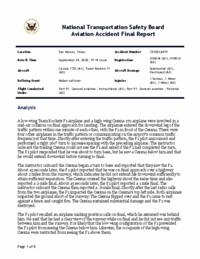
ASN Wikibase Occurrence # 243098
This information is added by users of ASN. Neither ASN nor the Flight Safety Foundation are responsible for the completeness or correctness of this information.
If you feel this information is incomplete or incorrect, you can submit corrected information.
| Date: | Thursday 24 September 2020 |
| Time: | 18:18 LT |
| Type: |  Cessna 172S Skyhawk SP |
| Owner/operator: | private |
| Registration: | N108VK |
| MSN: | 021 |
| Fatalities: | Fatalities: 0 / Occupants: 1 |
| Aircraft damage: | Destroyed |
| Category: | Accident |
| Location: | San Marcos Regional Airport (KHYI), Austin, TX -
 United States of America United States of America
|
| Phase: | Landing |
| Nature: | Training |
| Departure airport: | Lockhart, TX (50R) |
| San Marcos Regional Airport, TX (KHYI) | |
| Investigating agency: | NTSB |
| Confidence Rating: |
A low-wing Team Rockets F1 airplane and a high-wing Cessna 172 airplane were involved in a mid-air collision on final approach for landing. The airplanes entered the downwind leg of the traffic pattern within one minute of each other, with the F1 in front of the Cessna. There were four other airplanes in the traffic pattern or communicating on the airport's common traffic frequency at that time. Shortly after entering the traffic pattern, the F1 pilot announced and performed a right 360° turn to increase spacing with the preceding airplane. The instructor onboard the trailing Cessna could not see the F1 and asked if the F1 had completed the turn. The F1 pilot responded that he was about to turn base, but he saw a Cessna below him and that he would extend downwind before turning to final.
The instructor onboard the Cessna began a turn to base and reported that they saw the F1. About 45 seconds later, the F1 pilot reported that he was on final approach over a highway about 2 miles from the runway, which indicates he did not extend his downwind sufficiently to attain sufficient separation. The Cessna crossed the highway about the same time and also reported a 2-mile final. About 45 seconds later, the F1 pilot reported a 1 mile final. The instructor onboard the Cessna then reported a .8-mile final. Shortly after the last radio calls from the two airplanes, the F1 impacted the Cessna on the Cessna's top left side. Both airplanes impacted the ground short of the runway. The Cessna flipped over and the F1 came to rest against a fence and caught fire. The Cessna sustained substantial damage and the F1 was destroyed.
The F1 pilot recalled an airplane making position calls on final, which he assumed was behind him. He said that he had a clear view of the runway while on final and he did not see any traffic between him and the runway. It is likely that the low-wing configuration of the F1 prevented the F1 pilot from seeing the Cessna below him. Likewise, the occupants of the high-wing Cessna were restricted from seeing the F1 above them.
Although the F1 pilot stated that he would extend his downwind leg, he did not extend it enough to gain safe separation from the Cessna, which resulted in the F1 and the Cessna arriving at nearly the same geographical point on 2- mile final at the same time. The standard position reports issued by both pilots were sufficient for the pilots to have had awareness of each other's position on final; however, neither comprehended the conflict between their airplanes, possibly due to the high volume of radio calls from other aircraft in the traffic pattern and both pilots' increased attention on preparing for landing.
Probable Cause: The F1 pilot's failure to see and avoid the lower altitude Cessna while on final approach for landing. Contributing to the accident were the restrictions to pilot visibility inherent to low- and high-wing airplanes, and both pilots' failure to recognize the conflict that developed between their airplanes.
Accident investigation:
 |
|
Sources:
NTSB CEN20LA419
Location
Media:
Revision history:
| Date/time | Contributor | Updates |
|---|---|---|
| 25-Sep-2020 06:02 | RobertMB | Added |
| 01-Oct-2020 19:33 | Iceman 29 | Updated [Embed code] |
| 27-Jun-2022 10:05 | ASN Update Bot | Updated [Time, Cn, Operator, Total occupants, Other fatalities, Nature, Departure airport, Destination airport, Source, Narrative, Category, Accident report] |
| 27-Jun-2022 11:34 | harro | Updated [Operator, Other fatalities, Departure airport, Destination airport, Narrative] |
Corrections or additions? ... Edit this accident description
The Aviation Safety Network is an exclusive service provided by:


 ©2024 Flight Safety Foundation
©2024 Flight Safety Foundation